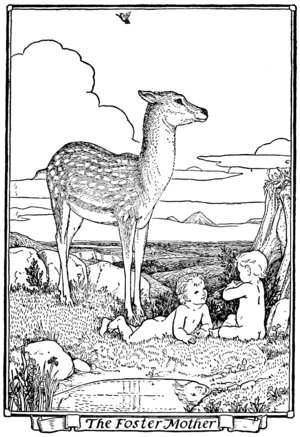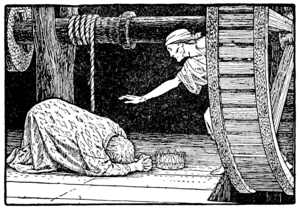The Dancing Water, the Singing Apple, and the Speaking Bird facts for kids
Quick facts for kids The Dancing Water, the Singing Apple, and the Speaking Bird |
|
|---|---|

The foster mother (doe) looks after the wonder-children.
|
|
| Folk tale | |
| Name | The Dancing Water, the Singing Apple, and the Speaking Bird |
| Data | |
| Aarne–Thompson grouping | ATU 707 (The Dancing Water, the Singing Apple, and the Speaking Bird; The Bird of Truth, or The Three Golden Children, or The Three Golden Sons) |
| Region | Eurasia, Worldwide |
| Related | Ancilotto, King of Provino; Princess Belle-Étoile and Prince Chéri; The Tale of Tsar Saltan; The Boys with the Golden Stars |
The Dancing Water, the Singing Apple, and the Speaking Bird is a famous Sicilian fairy tale. It was first collected by Giuseppe Pitrè. This story is a great example of a tale type known around the world. It is called Aarne–Thompson–Uther tale-type 707.
This story is also known by other names. Some of these are The Three Golden Sons or The Bird of Truth. Many people consider it one of the most well-known stories in the world.
Contents
The Story of the Dancing Water
This is a summary of the tale from Sicily.
A king was walking in the city. He heard three poor sisters talking. The oldest sister said she could serve water to the whole court from one glass. The second sister said she could dress the whole court from one piece of cloth. The youngest sister said she would have two sons with apples in their hands. She also promised a daughter with a star on her forehead if she married the king.
The next morning, the king made the older two sisters prove their claims. Then he married them to his butler and wardrobe keeper. He married the youngest sister himself. The new queen became pregnant. The king had to go to war. He left instructions to be told when his children were born.
The queen gave birth to the special children she had promised. But her older sisters were very jealous. They secretly replaced the babies with three puppies. They sent a message to the king, saying his wife had given birth to puppies. The children were taken away to be abandoned. The king was very angry. He ordered his wife to be put in a harsh prison.
Three fairies found the abandoned children. They gave them a deer to nurse them. They also gave them a purse full of money. And they gave them a special ring. This ring would change color if one of them was in trouble. When the children grew up, they moved to the city and found a house.
Their aunts saw them and were terrified. They sent their nurse to visit the daughter. The nurse told the girl that her house needed the magical Dancing Water to be perfect. She said her brothers should get it for her. The oldest son left to find it. He met three hermits. The first two could not help him. But the third told him how to get the Dancing Water. He brought it back home.
When the aunts saw the water, they sent their nurse again. She told the girl the house also needed the Singing Apple. The brother got this too, just like the water. The third time, they sent him after the Speaking Bird. But there was a rule: he must not talk back to the bird. The bird told him his aunts were trying to kill him. It also said his mother was in prison. This shocked him so much that he spoke. He immediately turned to stone. The magical ring changed colors.
His brother went after him. But he also suffered the same fate. Their sister then went to find them both. She said nothing to the bird. She rescued her brothers and many other stone statues.
They all returned home. The king saw them. He thought they looked like his children, but he believed his wife had given birth to puppies. The children invited him to dinner. The Speaking Bird then told the king everything that had happened. The king punished the aunts and their nurse. He brought his wife and children back to the palace.
What This Story is About
This fairy tale often follows a similar pattern around the world. Here's how it usually goes:
The king hears three sisters talking. The youngest says she would give him "wondrous children." These children often have special features like the sun, moon, or stars on their bodies. The king marries the youngest sister.
But the older sisters or another jealous relative get rid of the newborn children. They might replace them with animals. Or they might accuse the mother of harming them. The mother is then punished. She might be banished or put in a dungeon.
Meanwhile, a kind person or magical helper finds the children. They are raised far from their father's home. Years later, the children grow up. They might get help from a fairy or another magical being. They often move close to the king's palace.
The jealous relatives realize the children are alive. They send someone to tell the sister that her house needs special magical items. These items are usually three treasures. They might be:
- A magical water source (like a golden fountain).
- A magical tree or fruit (like apples that sing).
- A wondrous bird that can tell the truth and knows many languages.

The brother(s) go on a dangerous journey to find these items. They often get a special item from their sister. This item changes color to show if they are in danger. The brothers are warned not to listen to the bird. If they do, they will turn to stone. The first brother fails, and so does the next.
The sister sees the warning from the special item. She realizes her brothers are in danger. She goes to finish the quest and rescue them. She succeeds because she follows the rules.
Finally, the siblings invite the king to a feast. The magical bird tells the king the whole truth. The children are reunited with their parents. The jealous relatives are punished for their actions.
Different Versions of the Story
While the main story is similar, there are some differences in how it's told.
The Brother Looks for a Bride
In some versions, the sister is told to look for a beautiful woman or fairy. This woman replaces the bird in telling the truth. For example, in Albania, the quest is to find a fairy called "Beauty of the Land." In an Indian story, the brother finds a magical flower and a mirror. He also finds their owner, Lady Pushpavati, who marries him and tells the king the truth.
The Sister Marries a Prince
Sometimes, the sister rescues her brothers and also a prince from the petrifying spell. She then marries this prince. This happens in an Icelandic story. In a French version, the princess marries an enchanted old man who helps her get the magical items.
The Tale of Tsar Saltan
Some stories have the mother and babies put into a box and thrown into the sea. They wash ashore on an island. The child (or children) grow up very quickly. They build a magical castle. This castle attracts the king's attention. He visits and realizes these are his lost children. This version is famous in Russia, thanks to a poem by Alexander Pushkin.
The Boys With The Golden Stars

This type of story often starts with a woman giving birth to special babies. But an evil stepmother or grandmother kills them. The babies are reborn, sometimes as trees or animals, and then as humans again. They grow up fast and eventually reveal the truth to their father. This format is common in Eastern Europe.
Other Ways the Truth is Revealed
Sometimes, the magical bird is replaced by another character. In an Egyptian tale, a baby who can speak wisely tells the truth. In other versions, a fairy or magical woman tells the story. Very rarely, one of the children themselves reveals the truth to their father.
Where This Story is Told
This tale is popular all over the world, especially in Europe and Asia. You can find versions in:
- Europe: Italy, France, Spain, Portugal, Germany, Hungary, Scandinavia, Finland, Baltic countries, Russia, Poland, Czech Republic, Slovakia, Bulgaria, Slovenia, Serbia, Croatia, Belarus, Bosnia, Greece, Albania, Malta, and the British Isles (like Ireland).
- Asia: Turkey, the Middle East (including the famous Arabian Nights version), Iraq, India, and even Japan.
- Africa: It's very common in Southeast Africa. You can also find versions in North Africa (Morocco, Algeria, Egypt, Tunisia), Central Africa, West Africa (Cape Verde, Gold Coast), and Southern Africa.
- Americas: Versions exist in North America (United States, Canada, Mexico), Central America (Dominican Republic, Puerto Rico, Panama, Martinique, Guadeloupe, Haiti, Jamaica), and South America (Brazil, Argentina, Chile, Colombia).
Oldest Written Versions
One of the earliest known written versions is Ancilotto, King of Provino. This Italian fairy tale was written by Giovanni Francesco Straparola between 1550 and 1555. Other early versions appeared in Spain and France in the late 1600s and early 1700s.
Adaptations of the Tale
This fairy tale has inspired many other works:
- It influenced Carlo Gozzi's play The Green Bird. In this play, the green bird is a cursed prince who helps the imprisoned queen.
- A Canadian composer, Gilles Tremblay, created an opera based on the story in 2009.
- A Lithuanian poet, Oscar Milosz, adapted a traditional Lithuanian version, focusing on the characters' relationships.
Images for kids
-
The king begs his wife for forgiveness, after the truth is revealed. Illustration by John Batten for Joseph Jacobs's Europa's Fairy Book (1916).
-
The stepmother digs up a grave in the garden to bury the young princes. Illustration by Henry Justice Ford for Andrew Lang's The Violet Fairy Book (1901).





